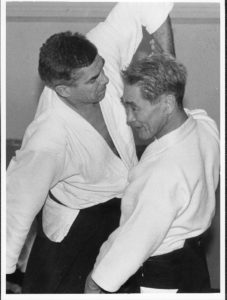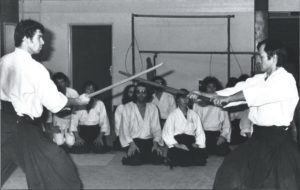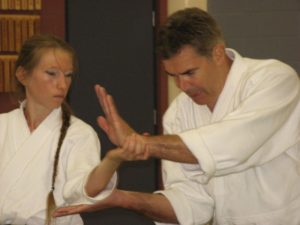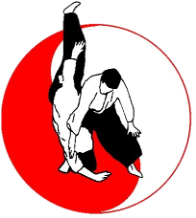The Spirit of Aikido
In the realm of martial arts or combat sports, Aikido is definitely unique in that there is an absence of competition, but also and above all, because of its stated intention to resolve a conflicting situation by causing the least possible damage to oneself as well as to the eventual attacker. Ideally, the goal would be to avoid all conflict. This spirit is clearly embodied by the very structure of this art.
This concept has first of all a practical purpose: not to kill (as was the case in the past), not to injure the opponent whether physically or mentally – not even to make him lose face – and thus avoid leaving any physical or mental “scars” that could trigger a feeling of revenge or seeking vendetta.
This notion also has much higher leanings which imply not leaving bodily or mental traces, but ideally speaking, not leaving any “karmic traces” either.
It is also profoundly rooted in Zen Buddhism. The wish to reduce as much as possible the consequences of a defensive movement is connected with the quest for a natural act whereby all “perfect action” is carried out “without having any attachment to its fruition”. It is only then that such an action leaves no trace (1).
A selfless and natural action is another way to describe it, including anything one might have to do to defend oneself. We do nothing unless it is strictly necessary or comes up as a natural solution. Actually, even in daily practice, it is important to think of stopping one’s blow, force, thrust (Jo) or cut (Ken, Iaïto, Shinken) when we practice the basic movements. This is how, on a higher level, one works in a spirit of forbearance and mercy.
This was Nishio Sensei’s motto (1927 – 2005) when he taught. It is not a coincidence that he entitled his only book (2) on Aïkido “Aïkido – Yurusu Budo”, that can be translated as “Aïkido – the Budo of forgiveness or forbearance”.
The English translation of the book calls it the “Budo of acceptance”. From this viewpoint, our discipline is based on mutual acceptance. To start with, the Tori (the one who is attacked) accepts the attack, dodging it at the very last moment. Then, as the technique unwinds, the Uke (the initial attacker) is required to accept an important change of situation. This is also why Nishio Sensei likened Aïkido to an exchange, an exercise of embracing, welcoming and tolerance.
Nishio Sensei often said that in most of the techniques – whether with bare hands, or with a Ken or Jo or sword – we have four or five opportunities to end brutally by striking a vital point with an atemi or by cutting with the sword. However, the ideal of Aïkido is not resorting to these solutions. Firstly, this allows one to perform the movement completely during Kumitachis that reproduce Aïkido techniques with bare hands. But through this forbearance, it also allows one to ask his “partner-opponent” at every step, “do we really want this?”

Nishio Sensei and Paul, CREPS de Strasbourg 1996.
In this way, Aïkido offers a new path – that of a Budo of embracing, welcoming and acceptance.
Aïkido was created by its founder O Sensei Morihei Ueshiba to enable us to follow the path of being, letting be, welcoming and forgiving, through each of its basic techniques.
This notion is present from the very beginning. In Aïkido, there is no “on guard” position, nor any waiting posture in particular, since that would already be akin to a provocation. It is just a natural posture. Kamae (the stance) is thus defined as Mu-Kamae (“no stance”). Surely, there is no visible physical stance, but mentally, the stance (vigilance and concentration) is very much present. With Nishio Sensei, it is true for bare-hand techniques, as well as with a Ken or a saber sword.
This notion is also reflected right after the attack, after the De-Aï (first contact) when an important phase occurs – that of “Michibiki” or the “handling” of the partner-opponent. It is in this phase that the whole spirit of Aïkido is conveyed, since it shows on a physical level how both actors in their interaction have switched from a situation of opposition (before and during the attack) to a situation where both of them agree to follow the same direction while performing the technique. If the movement unfolds accordingly, they become ONE, leading to the conclusion which is either an Ukemi or an on-ground control (Osae).
As O Sensei himself put it so beautifully: “Real BUDO is a labor of Love. It is about giving life to all beings and not killing or fighting against others. Love is the protector deity of all things. Nothing can exist without it. Aikido is a creation of Love. True BUDO is a loving protection of every being in a spirit of reconciliation. Reconciliation enables us to fulfill our mission. The secret resides in tuning into the movement of the universe and being in harmony with the universe itself.”
If one wants to really approach this path – this particular spirit of openness, acceptance and tolerance and thus ultimately that of love which should characterize all effort in Aïkido – it is essential to reduce the ego. And it is the way we practice and the way the Keiko (practice) is conducted that should lead to it. This is the very role of the Dojo.
The word DOJO, which is initially a religious term, refers to the place where one practices to attain the realization of the Path. It is a place where we are exposed, a place where in the olden days one faced life and death, but also inner creation and destruction, as well as inner nudity. Nowadays, at least, it is a place without discrimination, rich or poor, young or old, man or woman, strong or weak. It is a place where a true reduction of ego should take place through working on oneself both physically and mentally.
Each session should be experienced as a Misogi. The concept of Misogi emphasizes the particular aspect that each Aïkido session should take. It is also a religious term which has its origins in Shintoism. It refers to an ascetic activity aimed at purifying oneself. Thus, it is through an intensive practice, meant to provoke physical and mental exhaustion in a spirit of total abnegation that a Misogi exercise is carried out.

Chiba Sensei and Paul, CREPS Strasbourg 1975.
Exercises like Misogi play an important role in the practice of traditional Budos. This is why the founder of Aïkido, O Sensei, a devout Shintoist himself, based his art quite naturally on the Misogi principle. Applied to our discipline, it is about purifying the world by purifying oneself through the practice of Aïkido, as Nakazono Sensei used to say.
Practicing in this way to the point of exhaustion (Misogi) or practicing reasonably at a moderate pace as we generally do in our clubs – both ways are possible. But at the minimum, we need to practice on a regular and constant basis, in order to understand little by little with our body or deeply within ourselves, and not just at an intellectual level, what it means to be in harmony with a partner.
Without necessarily turning every Keiko into Misogi, there are two essential elements we need to apply to have a successful Aïkido session:
1°) Mindfulness. Being fully mindful and aware of what we do and experience each and every moment is a fundamental element of the practice. It is the implementation of the principle that is so dear to Nakazono Sensei: “Naka Ima”, “Here and now”. It is complete alertness and total presence that is required of us at every moment, just like the one we would have if we were dealing with a real life-and-death issue. We should never create a situation where we would have to apologize for an action made inadvertently on a tatami. This notion, expressed repeatedly by Nakazono Sensei, is also very present in Zen Buddhism: not doing anything absentmindedly.

Nakazono Sensei and Paul, Centre sportif Universitaire Strasbourg 1973.
It is this practice of mindfulness-awareness that gradually enables us to overcome ego, to go beyond the duality of subject-object, attacker-attacked, and to get direct insight through our body and essence into the basic unity that binds the two partners in movement.
Chiba Sensei, who was also a Zen monk, expressed the same idea : “The big mistake in the art of the sword is to pre-empt the outcome; you should not seek to know whether it would end in victory or defeat. Just let nature take its course and your sword will hit at the right time. The same is true in Aïkido. One should not adopt a dualistic attitude like most people do when they think in terms of “winning or losing”.
Instead, I see them as ONE, as an ACTION. The point here is that it is not about an action in the ordinary sense, but what I would call a PURE ACTION. This means an action without any motive or purpose. It is just a dynamic bodily expression of one’s liberty, one’s truth and inner beauty: the inner creation.”
2°) Physical attitude. During Aïkido practice, the mental attitude of mindfulness-awareness should go hand-in-hand with a certain physical attitude, which is physical loosening-up or relaxation. It is easily perceptible on bodies and faces. A scowling face and tense hunched up shoulders are the most obvious signs of an attitude that should be avoided. However, loosening up does not mean limpness or lack of muscular effort. The bodily work and exertion, as well as the muscle mobilization should be natural and smooth, minimizing and eventually eliminating all parasitic tensions that betray our fears, desire of domination etc. This triggers a more natural and deeper breathing that allows a more seamless and balanced practice.
But this is not any easier than remaining focused, because very often, absence of tension or simply of parasitic movements also implies having a good amount of detachment. Being detached means not getting caught up (especially on a mental level) by one’s partner or by the situation. This can be as difficult – or at times as simple – to apply as extreme alertness that we call “mindfulness-awareness”.
On another level, one also needs to be detached from oneself.
On the most practical level, it is easy to understand that we defend ourselves poorly when we are too keen on not losing anything, not getting hurt or not risking our life.
But the notion of detachment here is far beyond what is at stake in a competition or sparring. We must seek to give ourselves up and be self-detached, even as we are sitting alone meditating at home. Again, it is the same as this very ancient and widespread notion that is present in all major religions [see: John 12-25, The Bhagavad Gita, and also Meister Eckhart and Alan W. Watts (4)].
It is the highest stage in terms of ego reduction, often out of reach for ordinary people, but always the goal of all those who seek the absolute, whether they are martial artists or monks.

Élisabeth and Paul Muller, Mac Gill University Montreal 2006.
In conclusion, the spirit of Aïkido is very strongly connected to Zen spirit. Aikido should be understood as Zen in motion, where the quest is focused on Unity. It is about being in union with a partner, but also as Nakazono Sensei said, it is about being in union with the entire universe. Many of the experts quoted above use the same keyword to find this path : Love.
Paul Muller, 7th Dan Aïkikai
(1) “La Bhagavad Gita”, by Alain Porte, Ed. Aléa (édition de poche).
(2) “Aïkido – Yurusu Budo”, by Shoji Nishio, published by Aiki News.
(3) “Hinduism and Buddhism”, Ananda K. Coomaraswamy, edited by Golden Elixir Press.
(4) “The Wisdom of Insecurity”, by Alan W. Watts, edited by Pantheon Book
